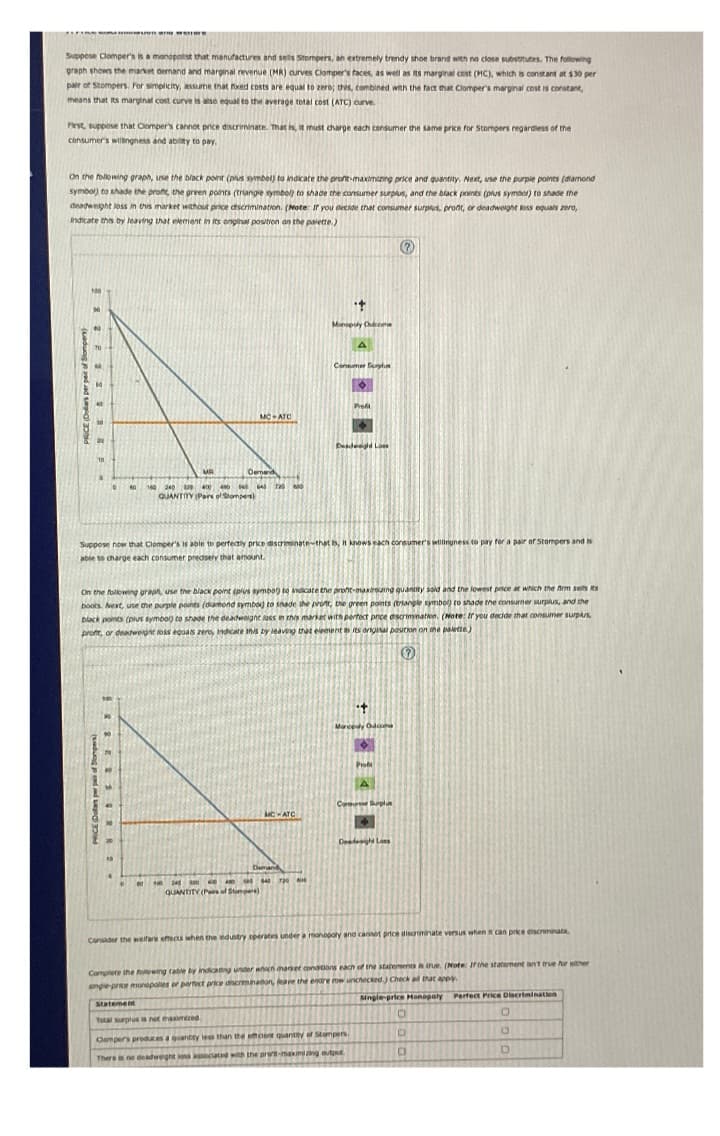PRICE (Dollars per pair of Stompers) Suppose Clomper's is a monopolist that manufactures and sells Stompers, an extremely trendy shoe brand with no close substitutes. The following graph shows the market demand and marginal revenue (MR) curves Clomper's faces, as well as its marginal cost (MC), which is constant at $30 per pair of Stompers. For simplicity, assume that fixed costs are equal to zero; this, combined with the fact that Clomper's marginal cost is constant, means that its marginal cost curve is also equal to the average total cost (ATC) curve. First, suppose that Clomper's cannot price discriminate. That is, it must charge each consumer the same price for Stompers regardless of the consumer's willingness and ability to pay. On the following graph, use the black point (plus symbel) to indicate the pront-maximizing price and quantity. Next, use the purple points (diamond symbol) to shade the profe, the green points (triangle symbol) to shade the consumer surplus, and the black points (plus symbol) to shade the deadweight loss in this market without price discrimination. (Note: If you decide that consumer surplus, pront, or deadweight loss equals zero, Indicate this by leaving that element in its orginal position on the palette.) PRICE (Dollars per pair of Stompers) t Monopoly A Consumer Surplu Pref MC-ATC MR Demand QUANTITY (Pairs of Stompers) Suppose now that Clemper's is able to perfectly price discriminate-that is, it knows each consumer's willingness to pay for a pair of Stompers and is able to charge each consumer precisely that amount. On the following graph, use the black point (plus symbog to indicate the pront-maxisang quantity sold and the lowest price at which the firm sets its boots. Next, use the purple points (diamond symbol) to shade the pront, the green ponts (triangle symbol) to shade the consumer surplus, and the black points (plus symbol) to shade the deadweight loss in this market with perfect price discrimination. (Note: If you decide that consumer surpas profit, or deadweight loss equals zero, Indicate this by leaving that element in its original position on the palette) QUANTITY (Ps of Stampers) Maddy Ode Prof Course Surplus MC-ATC Defight Loss Deman Consider the welfare effects when the industry operates under a monopoly and cannot price discriminate versus when it can price escriminate Complete the following table by indicating under which market conditions each of the statements is true. (Note: If the statement an't true for either single-price monopolies or perfect price discrimination, leave the enaire row unchecked.) Check all that apply Statement Single-price Monopoly Perfect Price Discrimination Total surplus is not maximized D Campers produces a quantity less than the emcient quantity of Stompers There is no deadweight loss associated with the prot-maximizing out 다 0 D D
Suppose Clomper's is a monopolst that manuractures and sels stampen, an extremely trendy shoe brand with na close substutes. The followng graph shows the market demand and marginal revenue
(
MR
)
ourves Clomper's taces, as wall as ins marginal cost
(
MC
)
,
which is constant at $
3
0
per pair of Stompers. For simplicty, assume that hxed costs are equal to zero; this, combined wah the fact that Clampers marginal cost is constant, means that its marginal cost curve is also equal to the
(
ATC
)
ourve. Trs
,
suppose that Compers camnct
,
it must darpe each consumer the same price for Stompers regardess of the consumer's wilingness and ability to pay. symod
)
to shade une pronc, une green pants
(
crange symbol
)
to shade che consumer surpus, and the black points
(
pius symood
)
to shade the Suppope now that Clomper's is able to pertecty prico discriminate
-
that is
,
it knows cach corsumer's
(
1
)
◻
Consider the weitare efrects when une industry operates under a
-
price manopolies or perfect
)
Oneck all chat apply. Statement Single
-
price Honopoly Perfect Price Discrimination Total surplus is not maximized. Compers produces a quantery less than the encient quantiay of scompers. There is no deadnegnt loss assoctated with the pron
-
maximizng output.

Trending now
This is a popular solution!
Step by step
Solved in 2 steps with 2 images









